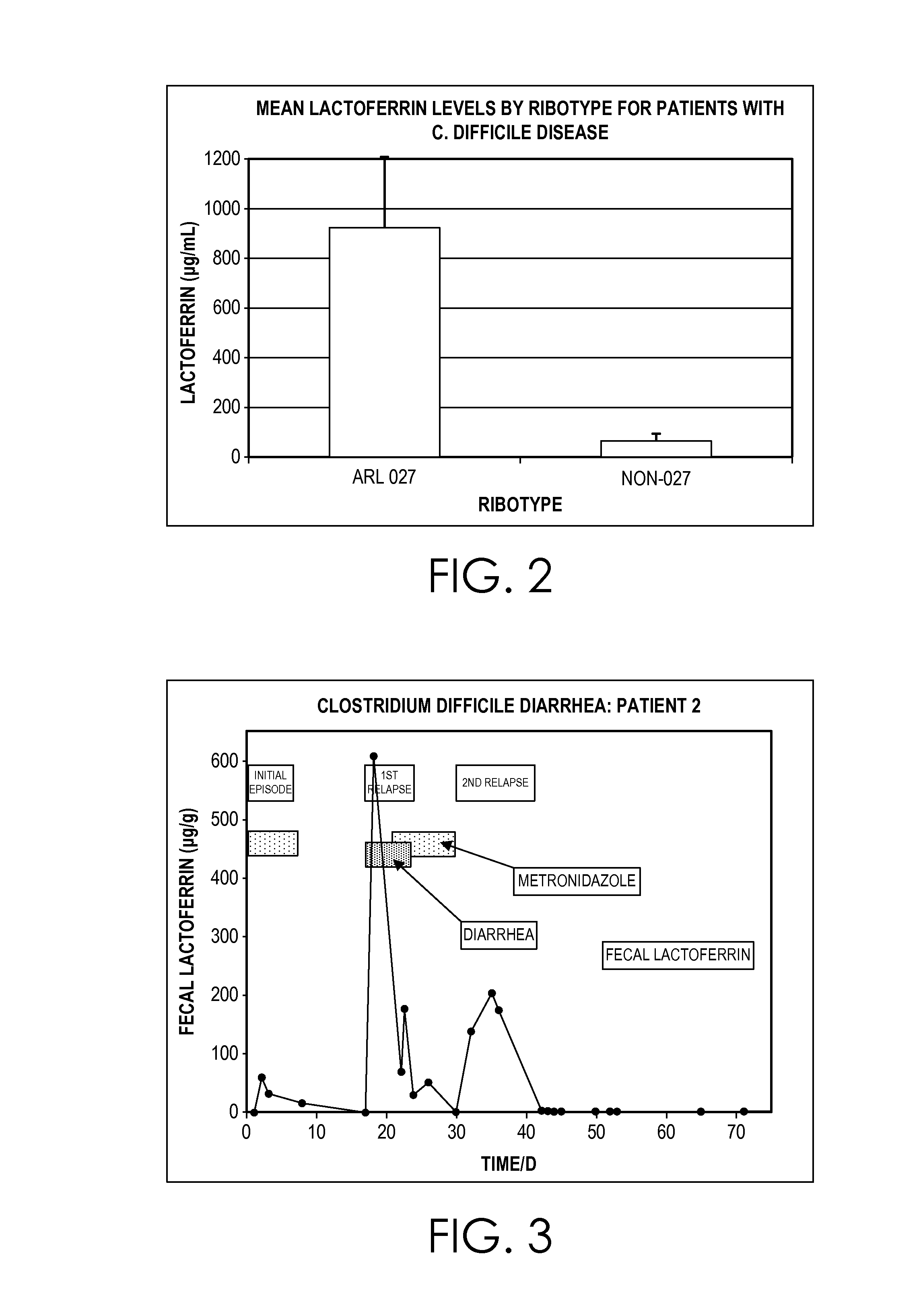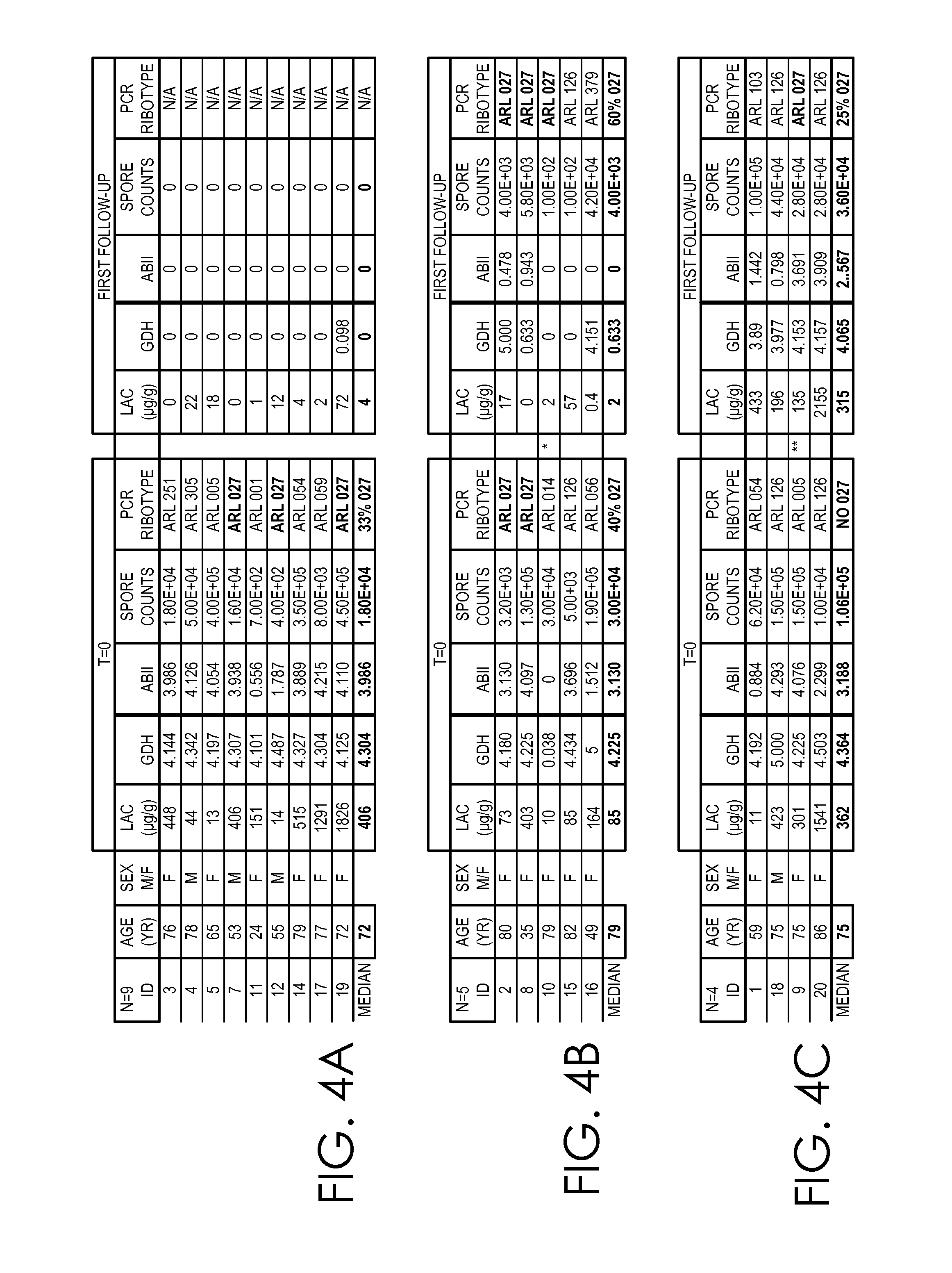Clostridium difficile dehydrogenase and toxin as a biomarker for monitoring infection in patients with clostridium difficile disease and differentiating carrier state from active disease
a technology of clostridium difficile and dehydrogenase, which is applied in the field of clostridium difficile dehydrogenase and toxin as a biomarker, can solve the problems of not providing information about the severity of disease or confirming that i>
- Summary
- Abstract
- Description
- Claims
- Application Information
AI Technical Summary
Benefits of technology
Problems solved by technology
Method used
Image
Examples
example 1
[0036]Fecal lactoferrin levels were evaluated in patients with clinically defined C. difficile disease ranging from mild to moderate-to-severe disease. Briefly, patients with clinically confirmed C. difficile disease presenting with a spectrum of severity were recruited along with fourteen age-sex matched healthy subjects defined as having no intestinal illnesses. Disease activity was defined by physician's assessment and based on symptoms, serum albumin, WBC counts and co-morbidities. Fecal lactoferrin was measured using a quantitative enzyme immunoassay (EIA). C. difficile glutamate dehydrogenase (GDH) and toxins A and B in stool were detected using a membrane-based EIA. Toxigenic culture was done using spore enrichment and both isolates and stool specimens were tested by tissue culture assay for cytotoxicity.
Results
[0037]Thirty-nine clinically confirmed cases of C. difficile disease (fifteen moderate-to-severe, twenty-one moderate and three mild) were tested during a six month pe...
example 2
[0040]Fecal C. difficile GDH, toxins A and B, and human lactoferrin levels were measured in several subjects with C. difficile disease during antibiotic treatment. Both subjects with clinically confirmed C. difficile disease were monitored for the presence of GDH, toxins A and B and fecal lactoferrin by enzyme-linked immunoassay (EIA). Specimen collection was initiated at the start of antibiotic treatment and was continued on a daily to weekly basis when possible. A symptom log was kept by each patient and all treatments were recorded during the test period. Both patients showed a rapid response to antibiotic treatment with fecal GDH, toxins A and B, and fecal lactoferrin reaching baseline within 24 hours. Antigen, toxin and fecal lactoferrin remained negative during the antibiotic therapy. Following the treatment, both patients experienced a clinical relapse and showed a rapid increase for all parameters. Following a second course of antibiotics, all parameters returned to baseline...
example 3
[0044]Patients (pts) with diarrhea and positive stool toxin (TcdA and TcdB) and / or glutamate dehydrogenase (GDH) were recruited with Informed Consent. Stool specimens were collected starting at admission (T=0) to Follow-up (T=F). GDH, toxin, and lactoferrin (LF: median μg / g) were measured in stool specimens by immunoassay. Bacterial culture and counts (median CFU# / g) were done using ethanol enrichment and isolates were ribotyped. A total of 18 inpatients were recruited and followed for a median period of 21 days from T=0 to T=F. Median age was 75yr and the male:female ratio was 1:3.5. Pts were stratified into 3 groups (i) pts who were treated and showed no recurrence (N=9). (ii) pts who were treated with complete resolution of symptoms but had CDI (N=5) and (iii) pts that responded initially to treatment but relapsed (N=4).
Results
[0045]Patients in group (i) went from strongly positive for GDH, toxin and a spore count of 104 at T=0 to negative for all biomarkers at T=F. LF fell from ...
PUM
| Property | Measurement | Unit |
|---|---|---|
| optical density | aaaaa | aaaaa |
| concentration | aaaaa | aaaaa |
| Optical Density | aaaaa | aaaaa |
Abstract
Description
Claims
Application Information
 Login to View More
Login to View More - R&D
- Intellectual Property
- Life Sciences
- Materials
- Tech Scout
- Unparalleled Data Quality
- Higher Quality Content
- 60% Fewer Hallucinations
Browse by: Latest US Patents, China's latest patents, Technical Efficacy Thesaurus, Application Domain, Technology Topic, Popular Technical Reports.
© 2025 PatSnap. All rights reserved.Legal|Privacy policy|Modern Slavery Act Transparency Statement|Sitemap|About US| Contact US: help@patsnap.com



